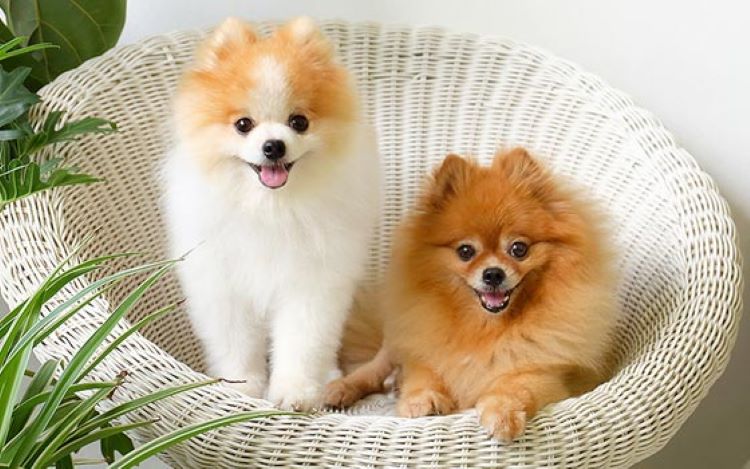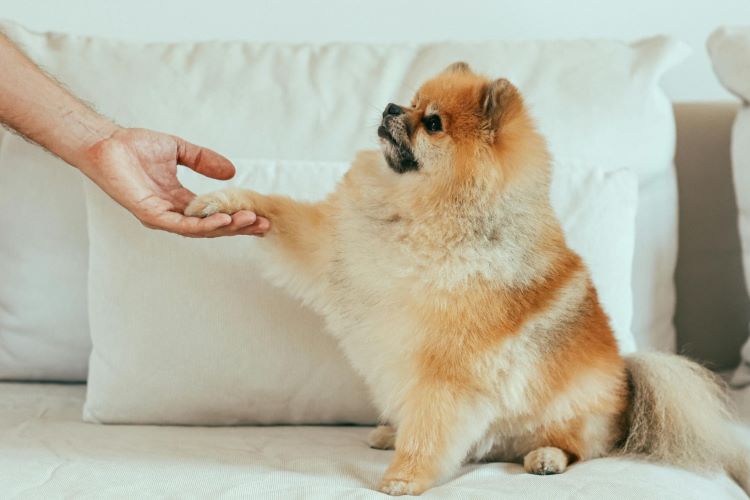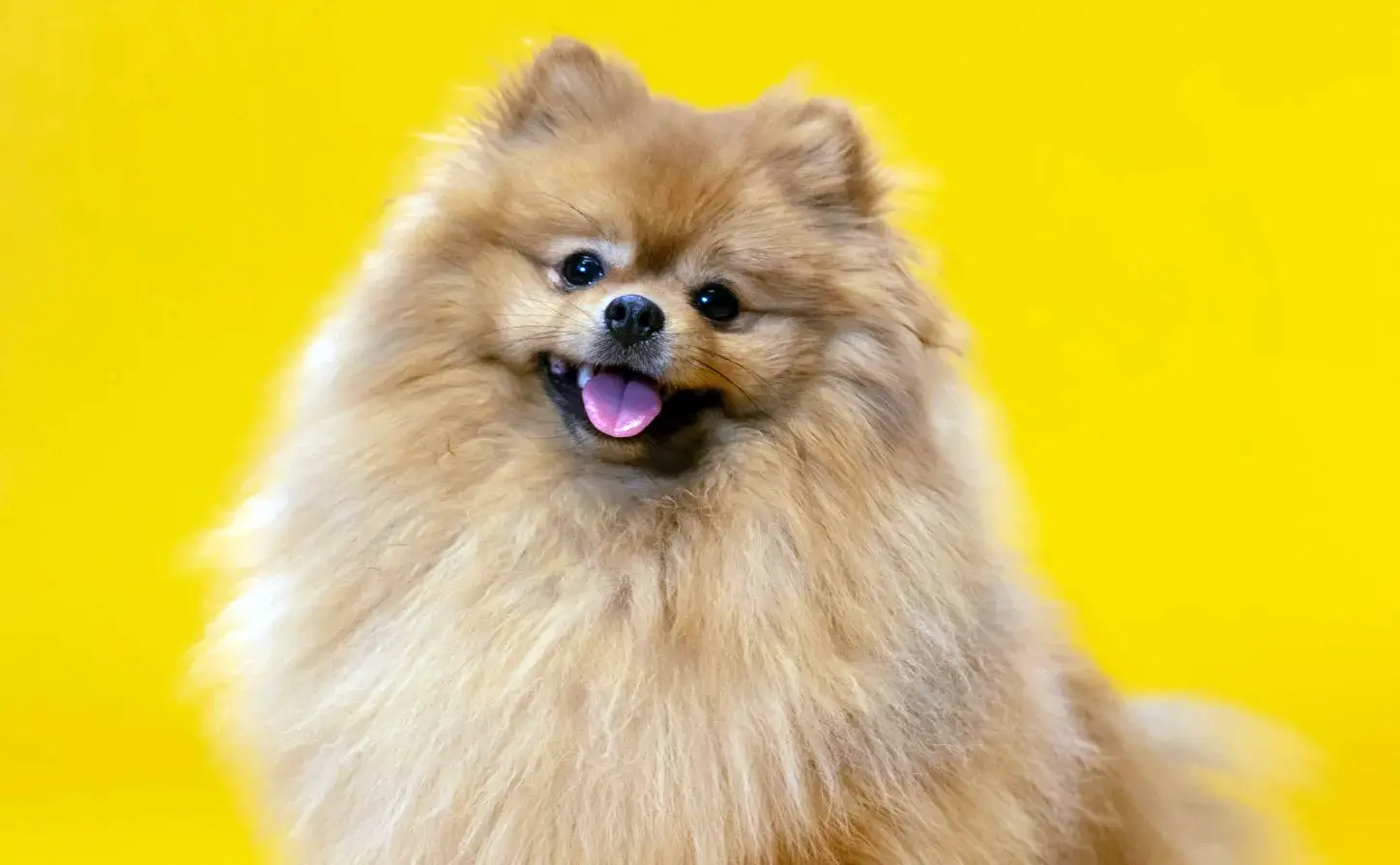Ready to help treat your pet to a healthy life?
A Guide to the Pomeranian Dog Breed: Health, Fun Facts & Floof
By : Trupanion Staff | Updated Jun 25, 2024

You might know that Pomeranians are small, fluffy dogs known for their lively personalities and distinctive appearance. But how much do you actually know about this fun and spirited breed that's won hearts worldwide?
Whether you're already a Pom parent or considering adding one to your family, this guide will provide you with all the essential information, tips, and fun facts you need to know. From their rich history to grooming tips and training advice, get ready to dive into the wonderful world of Pomeranians!
Get to know the Pomeranian
The Pomeranian or "Pom" is a delightful, spunky little dog that often seems to think it is much larger than it actually is. Their larger-than-life attitudes come wrapped in a small, often fluffy package that includes:
- Plumed tail that is held high and lays flat on their back
- Lion-like ruff on their neck and chest
- Short-backed body
- Pointy nose
8 fun facts about Pomeranians
- A small dog breed, Pomeranians sure are petite. They average just 8 to 14 inches (20 and 36 cm) tall and weight between 3 to 7 lbs. (1.3 and 3.1 kg).
- When two Pomeranians are together it’s called a “puff” — but three or more Poms equal a “tuft.”
- Poms have a lengthy lifespan compared to a lot of dog breeds. The average life expectancy falls between 12 and 16 years, though the longest-living Pomeranian was a dog named Coty, who reached 21 years, 8 months, and 13 days!
- The Pomeranian has been a favorite breed of creative types throughout history. Michelangelo painted the Sistine Chapel with his Pomeranian relaxing on a pillow nearby, and Mozart dedicated an aria to his Pom named Pimperl.
- Two of the three dogs that survived the sinking of the Titanic were Pomeranians (the third was a Pekingese).
- A Pomeranian in Los Angeles, named Jiff, held two world records: fastest dog to run 10m on his back legs and fastest dog to run 10m on his front legs! Jiff or "Jiff Pom" gained fame for more than that though — he was the breakout star in Katy Perry’s 2014 “Dark Horse” music video.
- While tiny today, the Pomeranian used to be much larger (allegedly between 20 and 40 lbs.) before Queen Victoria popularized the smaller size in the late 1800s.
- The Pomeranian is the smallest of the Spitz-type breeds, sharing genes with the Samoyed, Alaskan Malamute, Norwegian Elkhound, and are more closely related to the wolf than many other breeds.
Personality
A Pomeranian is a lively little sprite of a dog. Always willing to share their opinion, play, and entertain, Poms love attention and are very intelligent, which makes them an amazing training partner. They keep a sparkle in their eyes and are quite the smiling breed with their small, pointed noses and perky ears.
Pomeranians can be protective of their people and make great guard dogs since they’re always willing to bark. Just don’t tell them they aren’t the giant dog they think they are — not like they’d believe you anyway.
Similar dog breeds:
- Schipperke
- Papillon
- Keeshond
- American Eskimo Dog
- German Spitz
History of the Pomeranian
The Pomeranian is a Spitz-type dog, part of the unofficial group of Nordic-descended breeds that include the Samoyed, Keeshond, Norwegian Elkhound, Akita, and Alaskan Malamute. The Pom's predecessors were used in Iceland and other Northern areas as sled, herding, and guard dogs, making their way down to the European continent and becoming popular along the coast of the Baltic Sea.
These dogs were refined in an area of Germany and Poland called Pomerania (hence their name!), becoming smaller than their ancestors, but still larger than what we would recognize today, weighing between 20 to 40 lbs.
Changes over time
The breed made its way across Europe with quite a few appearances in 18th-century artwork, even being mentioned in British literature in 1764. Mozart owned a Pomeranian, as well as Michelangelo, who painted the Sistine Chapel while his Pom rested on a silk pillow nearby. But it wasn’t until Queen Victoria began breeding these puppies and showing her Pomeranians in the late 1800s that their popularity skyrocketed. This was also the catalyst for their downsizing to a toy breed.
Gifted a male Pomeranian named Marco in 1888, Queen Victoria fell in love with the breed, and Marco won quite a few titles in the show ring. During her reign, the size of Pomeranians shrank quite drastically as more people admired the small stature of Poms such as Marco, who weighed only 12 lbs. The first Pomeranian breed club was established in England in 1891.
North American History of the Pomeranian
As the Pomeranian became more popular in Britain in the late 19th century, so too did they become more common in the United States. While shown first in the miscellaneous class as early as 1892, the Pomeranian breed was officially recognized by the American Kennel Club in 1900. It wasn’t until 1988 that a Pomeranian would win Best in Show at the annual Westminster Dog Show when a 4 ½ lb. dog named Great Elms Prince Charming II snagged the title — currently the only Pomeranian to have won so far. The Pomeranian breed has consistently ranked in the top 20 most popular breeds in the United States and is a favorite companion of many celebrities.

Behavior and training
The Pomeranian is a high-energy and intelligent breed. Their intelligence makes them fantastic problem-solvers that love to learn new things with their owners. Their toy-breed status comes with common behavior issues that many smaller breed puppies struggle with, such as taking more time to housetrain and being on the "barky" side. But with patience and consistency in training, they make excellent companions!
Do Poms get along with others?
Pomeranians are typically quite social but might become protective of their owner and bark when people or other animals approach. Proper proactive exposure to new sights, sounds, people, dogs, and other animals as a young puppy is essential for their socialization skills.
It's worth noting that their small size makes living with young children difficult, as they can easily be injured with rough handling. However, they will do well with children if they’re socialized from puppyhood, and the children are respectful in their handling of the dog. Young children and dogs should always be supervised, and it’s helpful for a dog to have their own “safe space” where they can go when they need some quiet time.
When it comes to animal buddies in the home, it’s once again, all about socialization. As long as they have been properly socialized and introduced, Pomeranians can enjoy and benefit from the companionship of other animals. However, their small size makes injury more likely when playing or living with animals that are much larger, so be aware and monitor all interactions to make sure everyone stays safe.
Exercise requirements
While small, Pomeranians still have quite a lot of energy! Fortunately, their size makes it easy to exercise them, simply by walking around the home or around the block if the weather allows. Plus, Pomeranians love to play with toys, providing another opportunity for exercise and bonding.
Their petite size means they shouldn’t be jumping from heights. Even a seemingly small jump from the car or the back of the couch might cause injury. Pomeranians can even be seriously injured in jumps or a fall from their owner’s arms. They’ll appreciate easier access to their favorite couch nesting spots with a ramp or dog stairs, and should be lifted in and out of cars and on and off furniture.
Mental enrichment needs
It’s important (and fun!) to keep a Pomeranian’s brain engaged and provide mental enrichment. This will help keep them entertained and prevent unwanted canine behaviors. Teach new tricks, attend obedience classes, join a dog sport, and provide dog puzzles and interactive toys for your Pom to live its best life.
Common Behavioral Issues
The Pomeranians’ small size can sometimes lead to feelings of vulnerability or fear. As a result, they often learn to lash out defensively when they feel threatened. This can be prevented by working on gentle handling techniques from puppyhood and providing positive exposure training through introductions to a variety of people, animals, and environments that might otherwise be scary to such a small dog.
Pomeranians are frequently described as “yappy” dogs — and yes, they can bark! To avoid potential problems, they simply need to be taught what to do instead of barking (being quiet, or a nice sit-stay) when someone, for example, comes to the door. Their sharp intellect makes this type of training fairly easy. Though some owners don’t initially see the need for training a small dog, all dogs benefit from training programs and practices to help build good habits and establish bonds with their humans. Positive reinforcement training is crucial for a well-adjusted and happy Pomeranian!
Training tip
Inappropriate and aggressive behaviors such as nipping, biting, or resource guarding by Pomeranians are often seen as “cute” because they don’t cause serious injury the way a larger dog would. However, a dog displaying aggressive behaviors is usually doing so out of fear or insecurity. For the overall well-being of a Pomeranian (and everyone’s safety!), it's important that they aren’t forced to display these behaviors in an effort to be “cute” or “go viral” on social media. Responsible Pomeranian owners will help their dogs feel safe and teach them appropriate behaviors, using proper management and positive reinforcement methods.
Activities for Pomeranians
Pomeranians do well in many different activities:
- Small dog agility
- Trick training
- Nosework and tracking
- Flyball
- Canine freestyle
- Rally obedience
Care info for Pomeranian owners
Pomeranians are a healthy dog breed overall, though it is important to take note of your Pom's ancestry. Due to the breed's popularity — especially in recent years — irresponsible breeding may be a risk that can heighten health issues.
Like all dog breeds though, Poms may be more likely to get some health issues over others. This does not necessarily mean that they'll get sick; just that it's important to stay on top of routine healthcare and preventative measures. It's also a great idea to protect your pet with a good dog insurance plan if you have not done so already.
Common health conditions in Pomeranians
- Dental problems: Due to their small mouths, Pomeranians are prone to dental issues.
- Luxating patella: A condition where the kneecap dislocates.
- Tracheal collapse: A condition that affects the windpipe, common in small breeds.
- Hypoglycemia: Low blood sugar, particularly in puppies.
- Alopecia X: Also known as "black skin disease" or simply "AX," this is a hereditary condition causing hair loss and skin darkening.
Grooming
Poms have a thick double-coat that would have kept them warm in the cold Nordic winters and provided protection from the sun during the summers. They have a soft undercoat and longer, rougher guard fur that makes up their outer coat.
As long as a Pomeranian’s coat is brushed frequently, grooming isn’t too difficult to maintain at home. Brushing at least twice a week (or more often during seasonal shedding periods, usually around spring and fall) will prevent matting and distribute natural oils throughout the coat to keep it clean and shiny. Don’t forget to brush their tail either — the long plume is prone to matting!
Many Pom owners prefer to have a professional groomer care for their dog’s coat and have it trimmed shorter. It’s not advised to clip a double-coat, as it can result in uneven grow out, damage to the hair follicles, and increases the chance of sunburn and overheating. A double coat, when well-maintained, actually helps keep a dog cool, facilitating airflow across the skin. If you decide to have a double-coated breed clipped, whether per your veterinarian’s advice in dealing with skin issues or personal preference, it’s important to choose a groomer that knows how to avoid damaging the undercoat. Trimming will not reduce shedding. A Pomeranian will simply shed shorter (and often more prickly) fur. Regular brushing is your best bet to keep shedding hair contained.
Introduce your Pomeranian puppy to the grooming experience from a young age to create a positive association and encourage calm behavior during brushing and bathing.
Best Brush for a Pomeranian: Slicker Brush, Pin Comb

Pomeranians in pop culture
The fluffy, glamorous appearances of these dogs helps them fit in well with the arts and entertainment world.
Famous Owners of the Pomeranian
- Lisa Vanderpump (Reality Star/Entrepreneur)
- Sylvester Stallone (Actor/Writer)
- Fran Drescher (Actress)
- Mozart (Composer)
- Elvis Presley (Singer)
- Gwen Stefani (Singer)
- Eva Longoria (Actress/Director)
- Michaelangelo (Artist)
- LeAnne Rimes (Singer/Actress)
- Nicole Richie (Designer/Actress)
Famous Pomeranians in the 21st Century
- Boo, “The World’s Cutest Dog”
- JiffPom, a doggy influencer and Guinness World Record holder
